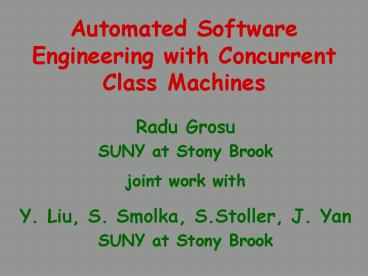Automated Software Engineering with Concurrent Class Machines - PowerPoint PPT Presentation
Title:
Automated Software Engineering with Concurrent Class Machines
Description:
Stack. Frame. Stack. Method Invocation Box (Call) run ... Stack. Frame. Stack. Their body is not known and not part of. Allow any update of public objects. ... – PowerPoint PPT presentation
Number of Views:105
Avg rating:3.0/5.0
Title: Automated Software Engineering with Concurrent Class Machines
1
Automated Software Engineering with Concurrent
Class Machines
Radu Grosu SUNY at Stony Brook joint work with Y.
Liu, S. Smolka, S.Stoller, J. Yan SUNY at Stony
Brook
2
Motivation (ASE)
- Automated OO software development method
- OO language for req.specification/modeling/implem
, - transition semantics capturing OO constructs,
- trace semantics supporting compositional
refinement, - analysis exploiting OO structure,
- generation of optimized (and monitored) code.
- Close the gap between
- object oriented methods (UML,OMT,),
- formal methods (Model Checking, Static
Analysis,).
3
Concurrent Class Machines (CCM)
- Modeling language for concurrent OO systems
- classes, inheritance, objects, object creation
- methods, exceptions, multithreading,
- abstract collection types, nondeterminism.
- 2. Observational trace semantics
- class machine refinement,
- modular reasoning.
- 3. Code generation and analysis
- prototype code generation.
- exploits the hierarchy information (in progress),
4
Readers/Writers Problem
Resource
Class Diagram
res
m
Monitor
1
1
m
Client
WrCap
5
Classes
attributes
Monitor
Call entry point
return exit point
methods
Method signature
6
Transitions
Monitor
transition (atomic)
guard (blocking)
assignments (parallel)
method can be declared atomic
7
Call Hierarchy (Boxes)
RdCap
local variables
return expression
choice point (nondeterminism)
return variable
method invocation box
object creation box
exception exit point
8
Concurrency
Client extends Thread
-m Monitor
main() void r Resource c Client
new Resource
r
m
c.start
new Monitor(r)
run() void
thread start box
thread run method
9
Operational Semantics
Transition system A (S, s0, ?)
10
Method Invocation Box
Client
-m Monitor
run() int r Resource i int
i
b
v
v
11
Method Invocation Box (Call)
Client
-m Monitor
run() int r Resource i int
i
b
v
v
12
Method Invocation Box (Return)
Client
-m Monitor
run() int r Resource i int
i
b
v
v
13
Environment (Interface) Objects
Static vars, streams
Allow compositional modeling reasoning
- Their body is not known and not part of ?
- Allow any update of public objects. The latter
are - determined via an escape analysis.
14
Denotational Semantics
- Execution of CCM m
- s0-gt s1-gt s2-gt -gt sn
- si-gt si1 is a CCM transition in ? or
- si-gt si1 is an environment transition.
- Set of Traces Lm of m
- Projection of executions on global variables.
- Object escape analysis is necessary.
- Refinement m lt n
- Inclusion of the sets of traces Lm ? Ln
- Compositional w.r.t. beh/arch hierarchies.
15
Modular Reasoning
lt
N
N
N
N
lt
N
N
lt
M
M
M
M
Sub-CCM refinement
Super-CCM refinement
16
Wrap Up
- Modeling language for concurrent OO systems
- classes, inheritance, objects, object creation
- methods, exceptions, multithreading,
- abstract collection types, nondeterminism.
- 2. Observational trace semantics
- class machine refinement,
- modular reasoning.
- 3. Code generation and analysis
- prototype code generation.
- exploits the hierarchy information (in progress),































